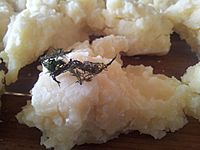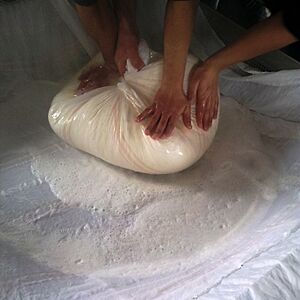Šar cheese facts for kids
Quick facts for kids Šar cheese |
|
|---|---|
 |
|
| Other names | Sharri cheese |
| Region | Šar Mountains |
| Source of milk | Cows, sheep |
| Pasteurized | Traditionally, no |
| Texture | Hard |
Šar cheese is a delicious, hard cheese that comes from the Šar Mountains in Kosovo. It is made using milk from both sheep and cows. People enjoy eating it in salads, with main meals, or simply with bread. This cheese is famous for its salty taste and can be enjoyed at any time of the day or year.
Contents
A Look Back: The History of Šar Cheese
The way Šar cheese is made has been passed down through families for hundreds of years. By the late 1800s, this special cheese became very popular. A newspaper from 1901 even wrote that its unique yellow color and taste made it stand out from other cheeses in nearby markets.
Why Sheep Milk Was First Used
Long ago, Šar cheese was mostly made from sheep's milk. This was because cows often couldn't climb high enough in the mountains to reach the best grasses and herbs. These plants gave the cheese its special flavor. One important herb is dill, which grows a lot in the mountains above 1,100 meters (about 3,600 feet).
Later, when people started using cow's milk, they began adding dill to the cheese during production. This helped keep the original taste and smell. Centuries ago, there were as many as 100,000 sheep in the region, but today that number is much smaller, around 5,000.
Unique Mountain Flavors
Šar cheese tastes different because the Šar Mountains are full of special herbs and plants. These plants make the milk richer and tastier. While the cheese is usually hard, there is also a soft version. For many years, people made this cheese by hand in old wooden shepherd huts or in their homes. Now, some companies also make it in factories.
How Šar Cheese is Made
Šar cheese is traditionally made in areas like Gora, Opolje, and Štrpce.
From Traditional to Modern Methods
Based on old recipes, Šar cheese is mostly made from sheep and cow milk. The type of milk used affects how much fat is in the cheese. Over the years, the way the cheese is made has changed from old traditional methods to more modern ones. This happened for two main reasons:
- To prevent diseases, by using a process called Pasteurization.
- To allow for industrial production of ingredients.
In the past, sheep milk was used at its natural temperature and not pasteurized. Today, milk is pasteurized before it's used to make cheese. After pasteurization, a special yeast is added to the milk to help it ferment. Long ago, this yeast came from sheep gallstones, but now it's bought ready to use.
The Cheese-Making Steps
After the milk ferments, it is poured into a cloth, like a diaper. It is then pressed to squeeze out the extra liquid, called Whey. The cheese (which is still soft at this stage) stays in the cloth until it becomes firm and changes color from white to light yellow.
Next, the cheese is taken out and placed on racks for a few days in cool, closed rooms. Finally, it is broken into pieces by hand. Salted water with Dill is prepared, and both the cheese pieces and the dill water are put into plastic jars for shipping.
Did you know that even the type of wood used for the racks can affect the cheese's smell and quality? For example, a type of wood called Pinus peuce is often used because it doesn't change the cheese's natural aroma.
About 25 tons of Šar cheese are made each year, mostly in the Dragaš region, using both sheep and cow milk. Šar cheese is known for being available all year, for its good quality, and its salty taste. While many families still make it at home, some companies have started making it in factories. Companies like ABI Industry and Sharri, both in Prizren, have been making this popular cheese for about ten years.
There isn't a big difference between how traditional and factory-made Šar cheese is produced. Factory-made cheese uses pasteurized milk and is ready to eat after two weeks. Traditional cheese needs more time to absorb the salt and ripen before it can be eaten.
Šar cheese is mostly sold in the Western Balkans. However, because many people from Kosovo live in places like Germany and Switzerland, cheese makers are now trying to sell their cheese in Western Europe too.
Different Kinds of Šar Cheese
There are two main types of Šar cheese: the traditional hard kind and a softer version. The biggest difference is how firm they are, but their saltiness and smell can also vary. The soft type appeared later, while the traditional hard type has been made the same way for a long time and is still the most popular.
Other cheeses that are similar to Šar cheese include White cheese and Cypriot Halloumi.
How People Enjoy Šar Cheese
Šar cheese is eaten a lot in cities like Prizren, Ferizaj, and Prishtina, but it's popular in other areas too. People usually prefer to buy the traditional hard Šar cheese over the soft kind. The most popular brand of Šar cheese in Kosovo is called "Sharri."
Families might buy anywhere from 2 to 10 kilograms (about 4 to 22 pounds) of Šar cheese each month. Restaurants also use a lot of it, about 43,000 kilograms (around 95,000 pounds) per year!
Original Šar cheese is often sold in wooden or plastic buckets in larger amounts, which makes it special. Sheep Šar cheese usually costs between 5 and 7 Euros per kilogram, while cow Šar cheese is around 4 Euros per kilogram. Regular buyers often purchase bigger quantities, from 5 to 20 kilograms, in these buckets.
The price difference comes from the higher quality of sheep's milk, which has more fat. This makes sheep Šar cheese the preferred choice, especially since it was the only type made in the very beginning.
Annotations



